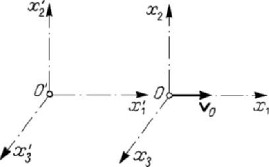Teodorescu P.P. Mechanical Systems, Classical Models Volume I: Particle Mechanics
Подождите немного. Документ загружается.


Dynamics of the particle with respect to an inertial frame of reference
371
0
11
xxvt
′′
=+,
22
xx
′
=
,
33
xx
′
=
;
(6.1.40')
Figure 6.3. Principle of relativity. The Galileo group.
it results that the set of these transformations contains only one essential parameter, that
is the magnitude
0
v
′
of the velocity of the frame R with respect to the frame
′
R . At
the moment
0t = (which can be taken as initial moment) the two frames coincide; we
notice that the inverse transformation
→
′
RR takes place too. As well, considering
also a frame
′′
R
and the transformation
→
′
′′
RR
, of the form
0
t
′′ ′ ′ ′
=+rrv,
tt
′′ ′
= , we observe that, by composition of the two transformations, we obtain the
transformation
→
′′
RR
, of the form
0
t
′
′′′
=
+rrv, tt
′
′
=
, hence a transformation
of the same set of transformations, if we accept the law of composition of velocities of
the relative motion
000
′
′′
=
+vvv;
(6.1.41)
in the case of particular frames which have the properties of Fig.6.3, hence in the case
of the transformation (6.1.40'), the law of composition of velocities is
000
vvv
′
′′
=
+ .
(6.1.41')
It results that the set of transformations (6.1.40) forms a group, denoted by
Γ and
called the Galileo group; this group contains three parameters.
We may attach to this group the group of time translations, denoted by
T and
containing one parameter, specified by
0
ttt
′
=
+ ,
(6.1.42)
which leads to a change of initial moment (which becomes
0
t
), as well as the group of
space translations in
3
E
, denoted by
T
, containing three parameters and expressed in
the form
0
′
′
=
+rrr,
(6.1.42')
so that the two frames can no more coincide. Combining these transformations, we may
write

MECHANICAL SYSTEMS, CLASSICAL MODELS
372
00
t
′′′
=+ +rrv r,
0
ttt
′
=
+ .
(6.1.42'')
We obtain thus a transformation which forms a group with seven parameters; in such a
transformation, the axes of the right-handed orthonormed frames
R and
′
R
remain
parallel to themselves. We obtain a rotation of the frame
R with respect to the frame
′
R
by the transformation (see also Chap. 2, Subsec. 1.1.2)
′
=rrα
,
iijj
xxα
′
=
, 1, 2, 3i
=
,
(6.1.43)
which forms the group of proper (finite) rotations in
3
E , denoted by SO(3) (the special
orthogonal group in
3
E ); this group contains only three distinct constants (which –
eventually – may be Euler’s angles), because the tensor
α
verifies the six relations of
orthogonality (3.1.35).
Finally, starting from the transformations (6.1.40), (6.1.42), (6.1.42') and (6.1.43),
we may set up the transformation
00
t
′
=+ +rrvrα ,
0
ttt
′
=
+ ,
(6.1.44)
which forms a group with ten parameters, denoted by
G and called the Galileo-Newton
group; the groups
Γ , T, T and SO(3) are subgroups of the group G. In particular, for
= 1α we find again the transformation (6.1.42'').
1.2.4 General theorems
Starting from the equation of motion (6.1.22), written with respect to an inertial
frame of reference
R, considered fixed, we may state some theorems with a general
character, consequence of this equation, which are known as the general (universal)
theorems of the dynamics of the particle.
Taking into account the momentum (6.1.1) and that the mass
m of the particle is
constant, we may write the equation (6.1.22) in the form
d
dt
=
H
HF
=
,
ii
HF
=
, 1, 2, 3i
=
,
(6.1.45)
corresponding to the second law of mechanics, so as it was stated by Newton (see also,
Chap. 1, Subsec. 1.2.1); we may thus state
Theorem 6.1.7 (theorem of momentum). The derivative with respect to time of the
momentum of a free particle is equal to the resultant of the given forces which act upon
it.
This form of Newton’s second law is the same as that stated by Einstein in the
Special Theory of Relativity.
If we perform a left vector product of the relation (6.1.22) by
r and notice that
[]
d
() () () ()
d
mmmm
t
××+×=×
rvrvrvrr= ,

Dynamics of the particle with respect to an inertial frame of reference
373
introducing also the moment of momentum (6.1.2), then we may write
d
d
O
OO
t
=×=
K
KrFM=
,
Oi Oi
KM=
, 1, 2, 3i
=
;
(6.1.46)
we obtain thus
Theorem 6.1.8 (theorem of moment of momentum). The derivative with respect to time
of the moment of momentum of a free particle with respect to a fixed pole is equal to the
moment of the resultant of the given forces which act upon it, with respect to the same
pole.
By means of the notion of hodograph, introduced in Chap. 5, Subsec. 1.2.1, we may
give a kinematic interpretation to the Theorems 6.1.7 and 6.1.8 too, stating:
Theorem 6.1.7'. The velocity of a point which describes the hodograph of the
momentum of a free particle with respect to a fixed pole is equipollent to the resultant
of the given forces which act upon it.
Theorem 6.1.8'. The velocity of a point which describes the hodograph of the moment
of momentum of a free particle with respect to a fixed pole is equipollent to the moment
of the given forces which act upon it, with respect to the same pole.
The torsor of the momentum, specified by the relation (6.1.4) allows to write
d()
() ()
d
O
OO
t
τ
τ= τ
H
HF
=
,
(6.1.47)
where we took into account the formulae (6.1.45), (6.1.46); therefore, we state
Theorem 6.1.9 (torsor’s theorem). The derivative with respect to time of the torsor of
the momentum of a free particle with respect to a fixed pole is equal to the torsor of the
resultant of the given forces which act upon it, with respect to the same pole.
The relation (6.1.45) may be written also in the form
ddtHF
=
, (6.1.45')
wherefrom
2
1
21
() () d
t
t
tt tΔ−
∫
HH H F==;
(6.1.45'')
the variation of the momentum of a free particle in a finite interval of time is thus
emphasized. The quantity
2
1
d
t
t
t
∫
F represents the impulse of the given force,
corresponding to the interval of time
[
]
12
,tt .
As well, another form of the relation (6.1.46) is
dd
OO
tKM
=
, (6.1.46')
so that
2
1
21
() () d
t
OO O O
t
tt tΔ−
∫
KK K M==,
(6.1.46'')

MECHANICAL SYSTEMS, CLASSICAL MODELS
374
and the variation of the moment of momentum of a free particle in a finite interval of
time is put into evidence; the quantity
2
1
d
t
O
t
t
∫
M represents the impulse of the moment
of the given force with respect to the pole
O , corresponding to the interval of time
[
]
12
,tt . Analogously, we get the variation of the torsor of the momentum of a free
particle in a finite interval of time in the form
(
)
2
1
() d
t
OO
t
tΔτ = τ
∫
HF
.
(6.1.47')
The above considerations play an important rôle in the case of an interval of time and
– particularly – in the case of discontinuous phenomena.
If we return to the kinetic energy
T , introduced in Subsec. 1.1.2, we may write the
relation
dd dTW
=
⋅Fr
=
; (6.1.48)
hence, we state
Theorem 6.1.10 (theorem of kinetic energy). The differential of the kinetic energy of a
free particle is equal to the elementary work of the resultant of the given forces which
act upon it.
Dividing the relation (6.1.48) by
dt and taking into account (6.1.16'), we can write
this theorem in a form closer to that of the previous theorems, i.e.
d
d
T
TP
t
=
=
,
(6.1.48')
obtaining thus
Theorem 6.1.10' (theorem of kinetic energy; second form). The derivative with respect
to time of the kinetic energy of a free particle is equal to the power of the resultant of
the given forces which act upon it.
We notice that the elementary work is an exact differential only in the case of a
conservative force (which derives from a simple or a generalized potential). In general,
this work is not a total differential (it is a Pfaff form) and the theorem of kinetic energy
is written in the form (for
[
]
12
,ttt
∈
)
12
2121
() ()
PP
TTt Tt T T WΔ= − = − =
22
12 1 1
ddd
tt
PP t t
tPt=⋅=⋅=
∫∫∫
Fr Fv ,
(6.1.48'')
integrating between
1
P and
2
P ; we may thus state
Theorem 6.1.10'' (theorem of kinetic energy; finite form). The variation of the kinetic
energy of a free particle in a finite interval of time is equal to the work of the resultant
of the given forces which act upon it in that interval of time.
The scalar product of relation (6.1.45'') by
2
v leads to

Dynamics of the particle with respect to an inertial frame of reference
375
2
1
2
2122
d
t
t
mm t−⋅=⋅
∫
vvvvF;
introducing the notations
2
11
1
2
Tm=
v ,
2
22
1
2
Tm=
v ,
21
TT T
Δ
=−,
2
00
1
2
Tm=
v ,
0
21
=
−vvv,
(6.1.49)
we may write
2
1
0
2
d
t
t
TT tΔ+ = ⋅
∫
vF,
(6.1.50)
wherefrom we state
Theorem 6.1.11. The sum of the variation of the kinetic energy of a free particle in a
finite interval of time and the kinetic energy of the variation of the velocity in the same
interval of time is equal to the scalar product of the impulse of the resultant of the given
forces corresponding to the considered interval of time by the velocity of the particle at
the final moment.
The scalar product of the relation (6.1.45'') by
1
v leads – analogously – to
2
1
0
1
d
t
t
TT tΔ− = ⋅
∫
vF;
(6.1.50')
we thus state
Theorem 6.1.11'. The difference between the variation of the kinetic energy of a free
particle in a finite interval of time and the kinetic energy of the variation of the velocity
in the same interval of time is equal to the scalar product of the impulse of the resultant
of the given forces, corresponding to the considered interval of time, by the velocity of
the particle at the initial moment.
Summing the relations (6.1.50) and (6.1.50') and taking into account the relation
(6.1.48''), we get
2
12
1
12
1
()d
2
t
PP
t
TW tΔ= = + ⋅
∫
vv F,
(6.1.51)
and we may state
Theorem 6.1.12 (Kelvin). The work of the resultant of the given forces which act upon
a free particle in a finite interval of time (the variation of the kinetic energy of the
particle) is equal to the scalar product of the impulse of this resultant, corresponding to
the considered interval of time, by the semisum of the velocities of the particle at the
initial and the final moment.
Subtracting the relations (6.1.50) and (6.1.50') one of the other, we may write
2
1
00
1
d
2
t
t
Tt=⋅
∫
vF;
(6.1.51')

MECHANICAL SYSTEMS, CLASSICAL MODELS
376
we get
Theorem 6.1.12' (analogous of Kelvin’s theorem). The kinetic energy of the variation
of the velocity of a free particle in a finite interval of time is equal to half of the scalar
product of the impulse of the resultant of the given forces, corresponding to the
considered interval of time, by the variation of the velocity in the same interval of time.
Figure 6.4. General theorems with respect to a movable pole.
The general theorems stated above take place in an inertial frame of reference
R,
considered fixed; the theorems of moment of momentum and of torsor, which depend
on the pole
O
, maintain their form also with respect to another pole Q , rigidly linked
to the frame
R (fixed with respect to this frame). If the pole Q is movable and the
calculation is made with respect to the frame
R too, the momentum
H
remains
invariant, but the moment of momentum and the moment of the resultant of given
forces become (Fig.6.4)
()
OQ QQ
=× = + × = + ×
KrHrrHKrH
,
OQQ
=
+×MMrF;
in this case, replacing in relation (6.1.46) and taking into account the relation (6.1.45),
we may write
d
d
Q
QQQ
t
==−×
K
KMvH
,
(6.1.52)
obtaining thus a generalized form of the theorem of moment of momentum. As a
consequence, the formula (6.1.47) is generalized in the form
{}
d()
() () ,
d
Q
QQQ
t
τ
τ= =τ− ×
H
HF0vH
.
(6.1.52')
1.2.5 Conservation theorems
If the resultant F of the given forces which act upon the particle P fulfils certain
conditions, then the general theorems presented in the previous subsection allow to state
some conservation theorems. Thus, if the force
F is parallel to a fixed plane (is normal
to a fixed direction of unit vector
u with respect to the frame R or has a zero
component), then the theorem of momentum allows to write

Dynamics of the particle with respect to an inertial frame of reference
377
d( )
0
dt
⋅
⋅= ⋅+ ⋅= =⋅=
Hu
Hu Hu Hu Fu
,
wherefrom
()
ii ii
mHumvuC⋅= ⋅= = =Hu v u , constC
=
;
(6.1.53)
we obtain thus a scalar first integral of the equations of motion. Hence, if the force
F is
parallel to a fixed plane, then the projection of the velocity of the free particle
P on the
normal to this plane is conserved (is constant) in time; associating a particle
P
′
to the
projection of the particle
P on this normal, we may state that the particle P
′
has a
uniform motion. Because
d
() () ( )
d
mmm C
t
⋅
=⋅= ⋅=
vu ru ru ,
it results
()
ii
mmxuCtC
′
⋅= = +ru , ,constCC
′
=
,
(6.1.53')
being thus led to a new scalar first integral, independent of the previous one; the
mentioned condition allows us to set up two independent scalar first integrals. As well,
if the force
F has a fixed direction (is normal to two distinct fixed directions with
respect to the frame
R or has two zero components), then one obtains four
independent scalar first integrals of the form (6.1.53), (6.1.53'), while the projection of
the velocity of the particle on a plane normal to the given force (determined by the two
fixed directions) is conserved in time. Eliminating the time between the two first
integrals of the form (6.1.53'), we may state that – in this case – the trajectory of the
particle
P is a plane curve, the support of the force F being contained in the plane of
the curve too. We may start also from the equation of motion
()mFt
=
ru, vers const==
uF ,
wherefrom one obtains the vector
d()dmtFttt
′
−= +
∫∫
rC u C, ,const
′
=
CC ,
as a linear combination of the constant vectors
u
and C , hence it is contained in the
plane defined by these vectors. Associating a particle
P
′
to the projection of the
particle
P on a normal to the direction of the force F in the considered plane, we
notice that this particle has a uniform and rectilinear motion.
Finally, if the force
F vanishes (is normal to three distinct fixed directions), then we
may build up three independent scalar first integrals of the form (6.1.53). Besides,
=F0 leads to =
H0
, so that
m==HvC, const=
C ,
ii
HC
=
, 1, 2, 3i
=
;
(6.1.53'')

MECHANICAL SYSTEMS, CLASSICAL MODELS
378
hence we get a vector first integral, equivalent to three independent scalar first integrals.
We may state
Theorem 6.1.13 (conservation theorem of momentum). The momentum (and the
velocity) of a free particle is conserved in time if and only if the resultant of the given
forces which act upon it vanishes.
We notice that the relation
mm
=
=
vrC leads to
mt
′
=+rC C,
,const
′
=
CC
,
ii i
mx C t C
′
=
+ ,
1, 2, 3i
=
;
(6.1.53''')
we obtain thus a new vector first integral, equivalent to three scalar first integrals. The
conservation theorem of momentum allows to set up two independent vector first
integrals or six independent scalar first integrals (the maximal number of independent
scalar first integrals which can be obtained). The motion of the particle
P is thus
rectilinear and uniform, being completely determined with respect to the frame
R.
Besides, this result corresponds to the principle of inertia, which appears thus as a
particular case of the principle of action of forces; however, this principle preserves its
independence, because it is not necessary to introduce the notion of zero resultant
(
=F0), as well as because it can lead to a selection of the solution of the problem
with initial conditions (of Cauchy type) if not all the conditions asked by the sufficient
theorem of existence and uniqueness are fulfilled. As it was seen above, this principle is
not in contradiction with the other principles. We notice also that this principle
maintains its form in relativistic mechanics, even if it cannot be deduced by
particularizing.
Analogously, if the moment
O
M
is contained in a fixed plane (is normal to a fixed
axis
Δ , O Δ∈ , of unit vector u , with respect to a frame R, or has a vanishing
component), the theorem of moment of momentum leads to
d
() 0
d
OOO
t
⋅
=⋅=⋅=
Ku Ku Mu ,
so that
(, , )
iij
OOiijkk
mKumxvuC⋅= = =∈ =Ku rvu , constC
=
,
(6.1.54)
resulting thus a new scalar first integral of the equations of motion. The mentioned
condition holds if and only if the force
F is coplanar (concurrent or parallel) with the
axis
Δ ( 0M
Δ
= ); in this case, the projection of the moment of momentum
O
K on the
axis
Δ is conserved in time. If, in particular, the axis Δ coincides with the axis
3
Ox ,
we have
()( )
12 21 12 21
mxv xv mxx xx C−= −= , constC
=
.
(6.1.54')
As well, if the moment
O
M has a fixed support (is normal to two distinct fixed axes
1
Δ and
2
Δ with respect to the frame R or has two zero components), then we obtain

Dynamics of the particle with respect to an inertial frame of reference
379
two independent scalar first integrals of the form (6.1.54). This condition holds if and
only if the force
F is contained in a fixed plane Π (normal to the direction of the
moment
O
M and passing through
12
O ΔΔ
≡
∩ ) or the support of the force F passes
through the point
O . Indeed, if the axes
1
Δ and
2
Δ coincide with the axes
1
Ox and
2
Ox , respectively, the relations
23 32
1
0
O
MxFxF≡−=
,
31 13
2
0
O
MxFxF
≡
−=
lead to
(
)
12 312213
12 3
0
OO O
xM xM x xF xF xM+=− −=−=;
hence, we may have
3
0x = or
3
0
O
M
=
.
In the first case, the field of forces
F being coplanar, the trajectory of the particle P
is a plane curve contained in the plane
Π , while the moment of momentum
O
K is
normal to this plane. In the second case,
O
=
M0 (the moment
O
M is normal to three
distinct axes, so that we may set up three independent first integrals of the form
(6.1.54). Besides,
O
=M0 leads to
O
=
K0, so that
()
O
m=× =Kr vC, const=
C ,
j
i
Oi ijk k
KmxvC=∈ = , 1, 2, 3i
=
, (6.1.54'')
hence a vector first integral, equivalent to three scalar first integrals; we may state
Theorem 6.1.14 (conservation theorem of moment of momentum). The moment of
momentum of a free particle with respect to a fixed pole is conserved in time if and only
if the moment of the resultant of the given forces which act upon it, with respect to the
same pole, vanishes.
We notice that the conservation theorem of momentum entails the conservation
theorem of moment of momentum; hence, the vector first integral or the three
corresponding scalar first integrals, given by the moment of momentum conservation
theorem, are not independent of the six scalar first integrals given by the momentum
conservation theorem. In this case, we may write
() const
O
τ=
H
(6.1.54''')
and we may state
Theorem 6.1.15 (conservation theorem of torsor). The torsor of the momentum of a
free particle with respect to a fixed pole is conserved in time if and only if the resultant
of the given forces which act upon it vanishes.
Considering only the vector first integrals (6.1.53'') and (6.1.54''), which form the
first integral of the torsor (6.1.54'''), one obtains six scalar first integrals (we do not take
into account the vector first integral (6.1.53''')), which are not independent, being linked
by the relation
0⋅=CC (consequence of the relation (,, )0
O
mm
⋅
==HK vr v ).

MECHANICAL SYSTEMS, CLASSICAL MODELS
380
We notice that, in the frame of the Theorem 6.1.15, the torsor of the force
F
vanishes too. As a matter of fact, the torsor conservation theorem allows to write nine
scalar first integrals, from which only six are independent.
If the force
F is contained in the fixed plane
12
Ox x , then we have
3
0F = ,
12
0
OO
MM== and we may build up four first integrals
13 3
f
vC≡=,
233 3
f
xCtC
′
≡
−=,
1
32332
C
fxvxv
m
≡−=
,
2
43113
C
fxvxv
m
≡−=
,
3312
,,, constCCCC
′
=
,
which are independent, because the matrix
()
()
1234
32 32
123123
313 1
00000 1
00100 0
,,,
00
,,,,,
00
ffff
vv xx
xxxvvv
vvx x
⎡
⎤
⎢
⎥
∂
⎢
⎥
⎡⎤
=
⎢
⎥
⎢⎥
−−
∂
⎣⎦
⎢
⎥
⎢
⎥
−−
⎣
⎦
is of rank four (e.g., the determinant of the fourth order formed by the last four columns
does not vanish). If we put the initial conditions in the plane
12
Ox x , then we notice that
33
0CC
′
==; the other first integrals lead to
12
0CC
=
= . The co-ordinates
11
()xxt= and
22
()xxt= and the components of the velocity
11
()vvt= ,
22
()vvt= remain to be determinate. Thus, the theorems of linear and angular
momentum may give independent first integrals; but such a result cannot be obtained
always. Thus, if the force
F is parallel to the fixed axis
3
Ox (without having –
necessarily – a fixed support), then we have
12
0FF
=
= ,
3
0
O
M
=
and we may set
up five first integrals
11 1
f
vC≡=,
211 1
f
xCtC
′
≡− =,
32 2
f
vC
≡
= ,
422 2
f
xCtC
′
≡
−=,
3
5
12 21
C
fxvxv
m
≡−=
,
11223
,,,, constCCCCC
′′
= ;
one may easily see that the last first integral is a consequence of the four first integrals,
having only four independent first integrals.
Using the considerations made in Subsec. 1.1.2, let us suppose that the resultant
F
of the given forces is a conservative force which derives from a simple or generalized
potential; in this case, the elementary work is a total differential and the formula
(6.1.48) leads to
TUh
=
+
(6.1.55)
or to
0
TU h
=
+ , (6.1.55')
